|
|
|
Sort Order |
|
|
|
Items / Page
|
|
|
|
|
|
|
| Srl | Item |
| 1 |
ID:
157903


|
|
|
|
|
| Summary/Abstract |
Protests and democratic transitions tend to spread cross-nationally. Is this true of all political events? We argue that the mechanisms underlying the diffusion of mass-participation events are unlikely to support the spread of elite-led violence, particularly coups. Further, past findings of coup contagion employed empirical techniques unable to distinguish clustering, common shocks, and actual diffusion. To investigate which events diffuse and where, we combine modern spatial dependence models with extreme bounds analysis (EBA). EBA allows for numerous modeling alternatives, including diffusion timing and the controls, and calculates the distribution of estimates across all combinations of these choices. We also examine various diffusion pathways, such as contagion among trade partners. Results from nearly 1.2 million models clearly undercut coup contagion. In comparison, we confirm that more mass-driven political events robustly spread cross-nationally. Our findings contribute to studies of political conflict and contagion, while introducing EBA as an effective tool for diffusion scholars.
|
|
|
|
|
|
|
|
|
|
|
|
|
|
|
|
| 2 |
ID:
141856


|
|
|
|
|
| Summary/Abstract |
We assess how investors evaluate sovereign borrowers, arguing that sovereign risk is less “sovereign” than previous research assumes. Investors evaluate governments based not only on what they do, but also on investors' views of similar, “peer” countries. Professional investors use investment categorizations (geography, sovereign credit rating, or level of market development) as a heuristic device. As a result, peer country effects, as well as country-specific and global factors (booms, crises, or shocks), should explain sovereign interest rates. The peer effects we expect are regular features of international capital markets, rather than phenomena that occur in periods of market turmoil. We assess our expectations using error correction models of monthly sovereign risk premiums, which reveal significant interdependencies in sovereign risk assessments among countries, net of global and domestic predictors. Such contagion emerges principally in the short term, although we also find robust, long-term ties in sovereign risk assessments among countries sharing common regional classifications. Hence, our evidence suggests that professional investors' reliance on country categorizations facilitates the transmission of market sentiments—which include lower as well as higher risk premiums charged—across groups of countries, even when countries differ in key measures of creditworthiness. Our analyses highlight the importance of investors' ideas regarding country categorizations; they call into question the efficiency of sovereign debt markets.
|
|
|
|
|
|
|
|
|
|
|
|
|
|
|
|
| 3 |
ID:
101615
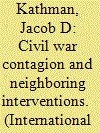

|
|
|
|
|
| Publication |
2010.
|
| Summary/Abstract |
Extant models of civil war intervention have difficulty accounting for the intervention decisions of third-party states that share a border with an ongoing civil war. This is troubling, as contiguous third parties account for a large proportion of interventions. I demonstrate that the tendency of civil wars to spread geographically pose neighbor states with threats to their well-being that are faced by no other type of intervener in the international system. Destruction, regime stability, even state survival are threatened by the prospect of civil war infection. I argue that neighboring third parties are thus motivated to intervene in an attempt to thwart war diffusion across their own borders. Through an analysis of civil war prevalence, I generate a measure of each state's yearly likelihood of being infected by a proximate civil war's hostilities. I then use this measure to explain neighboring interventions in civil wars of the post-WWII period. The results support my theorized expectations.
|
|
|
|
|
|
|
|
|
|
|
|
|
|
|
|
| 4 |
ID:
142038


|
|
|
|
|
| Summary/Abstract |
Violent domestic conflicts spread between countries via spillover effects and the desire to emulate events abroad. Herein, we extend this emulation logic to the potential for the contagion of nonviolent conflicts. The spread of predominantly nonviolent pro-democracy mobilizations across the globe in the mid-to-late 1980s, the wave of protests in former Soviet states during the Color revolutions in the 2000s, and the eruption of nonviolent movements across the Middle East and North Africa during the Arab Spring in the early 2010s each suggest that the observation of collective action abroad encourages a desire to emulate among potential challengers to domestic autocrats. However, the need to emulate varies. Potential challengers with a recent history of protest at home are less dependent (than are those without similar experience) upon foreign exemplars to mobilize the participants and generate the resources required to make emulation practicable. By contrast, where the domestic experience of protest is absent, opposition movements are more reliant upon emulation of foreign exemplars. We test the implications of this logic using a series of multivariate logistic regression analyses. Our tests employ data on nonviolent civil resistance mobilizations that occurred across the global population of autocratic states between 1946 and 2006. These tests, along with post-estimation analysis, provide evidence consistent with our conditional logic of emulation.
|
|
|
|
|
|
|
|
|
|
|
|
|
|
|
|
| 5 |
ID:
086602
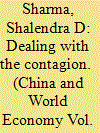

|
|
|
|
|
| Publication |
2009.
|
| Summary/Abstract |
What began as a downturn in the US housing sector in the summer of 2007 had mushroomed into a global financial crisis by September 2008: the most severe since the 1930s. Developing countries, including China and India, at first seemingly sheltered from the worst of the turmoil, have not been immune to the contagion's spillover effects. What are China and India's precise vulnerabilities, and what can each do to better insulate their economies from the vagaries of global financial marker turmoil? Equally important, what long-term strategies must each country adopt to make their economies more resilient to global market downturns?
|
|
|
|
|
|
|
|
|
|
|
|
|
|
|
|
| 6 |
ID:
193235
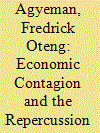

|
|
|
|
|
| Summary/Abstract |
The outbreak of the coronavirus disease in 2019 (COVID-19) wreaked havoc on the social, psychological, economic, and political buoyancy of all economic activities worldwide. The economic challenges caused by the interruption in worldwide economic activities significantly impacted remittances flow to low- and middle-income economies (LMIEs). This study used the past, present, and predicted remittances data of migration dynamics within countries to analyse the economic impact on remittances. Remittances to most LMIEs plunged during the pandemic intense period; however, the decline was temporary as the flows increased due to countrywide policies and individuals’ emergent needs. The trend of economic contagion is fundamentally unique in that even the primary source of remittance sending nations have been greatly impacted. The global nature of this pandemic raises numerous questions, including whether the decline in remittances will continue for a short term or will last for an extended period to stagnate LMIEs. This current study’s results reveal that while remittances flow to key recipient nations declined between 2019 and 2020, there has not been a sharp decrease and most of the nations were on the path of recovery in 2021. This study proposes that policymakers support remittances flow on a higher growth trend in successive years based on Sustainable Development Goals to attain global inclusive development. This research further recommends the adoption of higher technology transfer of remittances of migrant workers within the emerging and low- and middle-income economies.
|
|
|
|
|
|
|
|
|
|
|
|
|
|
|
|
| 7 |
ID:
099791


|
|
|
|
|
| Publication |
2010.
|
| Summary/Abstract |
This article investigates the effects of the Iraq war on terrorism in the West. Arguments from academics and from war-opponents and adherents are distilled into three hypotheses which are tested. To do this, a measure is created of terrorist activities in the West based on terrorist attacks and failed and foiled plots. The causal logic of the hypotheses is examined by piecing together data from various sources. Effects of the Iraq war are surprisingly hard to identify on terrorism in the West: It is difficult to corroborate that the Iraq war has drawn Islamist militant resources from the West, that Jihadist returnees should pose a significant threat, or that Muslims in greater numbers have been mobilized to terrorism. This does not disqualify transnational dynamics! Rather, it exemplifies how transnational dynamics in terrorism connects some parts of the globe, but not all, and not necessarily those most globalized. Immaterial factors, such as tactics from Iraq, have not been relevant in the West, but have had an effect in Afghanistan. Material factors like the return of Jihadists have not permeated to the West, but have had an effect in neighbouring countries.
|
|
|
|
|
|
|
|
|
|
|
|
|
|
|
|
| 8 |
ID:
182997
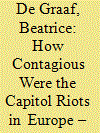

|
|
|
|
|
| Summary/Abstract |
This contribution presents a short overview on the impact of the Capitol Riots riots in Europe. Fear of a similar mass-mediated contagion was explicitly expressed by most of the European leaders. Echoes and acclamation for the riots in the U.S. were indeed heard on websites, QAnon-sites, and within circles of Trump supporters in Europe as well. An earlier storming of the German Reichstag (in 2020) was cited. In the Netherlands, the curfew riots of 24–25 January 2021 also were put into this context. Security agencies and officials in the U.K. and the Netherlands repeated this threat awareness in recent, formal threat assessments.
|
|
|
|
|
|
|
|
|
|
|
|
|
|
|
|
| 9 |
ID:
121865
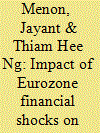

|
|
|
|
|
| Publication |
2013.
|
| Summary/Abstract |
Five years after the global financial crisis, the economies of the United States and the eurozone continue to struggle. How will Southeast Asian economies be affected should there be a further deterioration in conditions in the eurozone? In this paper, we present estimates using a Global Vector Autoregression (GVAR) model of the direct impacts of a further shock to the eurozone. We find that although the direct impacts are likely to be muted, it could trigger a much larger adjustment should it lead to a reassessment of risks and asset valuations. This is a real possibility given that vulnerability in the region has increased following massive inflows of capital and build-up of debt, related to successive bouts of quantitative easing in the United States initially, and now Japan. Should this happen, and with the IMF's resources already stretched, there is a pressing need to improve regional financial safety nets, which are currently unworkable, to deal with the fallout.
|
|
|
|
|
|
|
|
|
|
|
|
|
|
|
|
| 10 |
ID:
137726
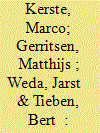

|
|
|
|
|
| Summary/Abstract |
The credit crisis points at serious systemic risks in Over The Counter derivative trading. This has resulted in new financial regulation, covering both the financial sector and non-financial sectors. The actual extent to which non-financial companies trading on OTC markets contribute to systemic risk has hardly been the subject of research. This paper investigates the need for financial regulation in the energy sector, which shows a high use of OTC derivatives, by modeling systemic risk measured by the expected fraction of additional failing firms (EAF). Contagion risk within the energy sector and from the energy sector towards the banking sector is compared with that in other non-financial sectors. This paper adds to existing systemic risk literature by specifically looking at financial interdependence between a non-financial sector showing a high usage of OTC commodity derivatives and the banking sector, while contributing to the discussion on energy sector regulation with technical systemic risk analysis. Results indicate that contagion risk from the energy towards the banking sector is not relatively high compared to other non-financial sectors. Our results provide a first indication to question the need for generalized regulation of OTC derivative transactions, as recently introduced by the European Market Infrastructure Regulation (EMIR).
|
|
|
|
|
|
|
|
|
|
|
|
|
|
|
|
| 11 |
ID:
125220
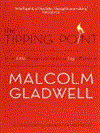

|
|
|
|
|
| Publication |
London, Abacus, 2013.
|
| Description |
279p.Pbk
|
| Standard Number |
9780349113463
|
|
|
|
|
|
|
|
|
|
|
|
Copies: C:1/I:0,R:0,Q:0
Circulation
| Accession# | Call# | Current Location | Status | Policy | Location |
| 057519 | 302/GLA 057519 | Main | On Shelf | General | |
|
|
|
|
| 12 |
ID:
169757
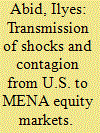

|
|
|
|
|
| Summary/Abstract |
Using a multifactor model augmented with oil and gas returns, this paper examines contagion from the US to MENA equity markets and studies the role of energy price fluctuations in amplifying the dependence between the US and MENA equity markets. We provide empirical evidence of a strong contagion effect originating from the US to MENA equity markets. The regional, oil and gas factors account for the bulk of the variance of the MENA equity returns and our findings suggest that the oil and gas markets play an important role in strengthening the dependence between the MENA and US markets during episodes of market turmoil. We discuss the policymaking importance of our results and propose a strategy to curb the adverse effects of US return shocks on MENA equity markets during episodes of stress.
|
|
|
|
|
|
|
|
|
|
|
|
|
|
|
|
| 13 |
ID:
177659
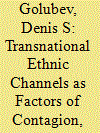

|
|
|
|
|
| Summary/Abstract |
The article raises the issue of why some transnational ethnic groups (TEGs) in the Middle East and North Africa (MENA) region are more effective transmitters of conflict and instability across established borders than others. The cases involving Kurds and Amazighs present some interesting variations of agency for both groups with regard to the external expansion of internal conflicts in some of the countries of their residence. A comparative analysis of the divergent experiences of Kurds and Amazighs with respect to contagion, internationalization (mostly through intervention), and what one might term the “proxyfication” of relevant conflicts in the region reveals some underlying factors that help construct the author’s main argument and working hypotheses for the large-N empirical part of this study. What emerges is strong empirical support for the proposition that four characteristics of MENA-based TEGs – namely, group discrimination, the relative size of the group, the ethnic polarization of the group’s state of residence, and the group’s territorial concentration – all to some extent serve as factors of external expansion of internal ethnic conflict. Out of these four features, group discrimination and the territorial concentration of the group, which are the factors about which the Kurds and Amazighs appear to differ the most, turn out to be the most reliable predictors of TEG-based conflict expansion.
|
|
|
|
|
|
|
|
|
|
|
|
|
|
|
|
| 14 |
ID:
124987


|
|
|
|
|
| Publication |
2013.
|
| Summary/Abstract |
The spread, diffusion, spillover, or contagion of violent civil conflict - including insurgencies, coups, or other internal armed conflict - across international borders is of great concern to civil war scholars and international security policymakers alike. For instance, great power military interventions are often predicated in part on the belief that if a given conflict is not stopped now, it may spread and destabilize an entire region. Nevertheless, our understanding of this phenomenon of 'substate conflict contagion' is hindered by the lack of a comprehensive and accurate universe of cases. In this article I introduce an original dataset of cases and non-cases of substate conflict contagion between 1946 and 2007. The key difference between my dataset and other datasets of this phenomenon is that I require in my definition of contagion not only the spatial and temporal proximity of two conflicts, but also a documented causal link between them. After introducing the dataset and the process by which it was constructed, I show that substate conflict contagion by my definition is significantly less common than previous scholarship and policymaker rhetoric suggest, and that its correlates - and potentially the best methods with which to measure those correlates - are different from prior research as well. Policy implications are considered, and applications of this dataset for future conflict research are explored.
|
|
|
|
|
|
|
|
|
|
|
|
|
|
|
|
| 15 |
ID:
124717
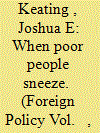

|
|
|
|
|
| Publication |
2013.
|
| Summary/Abstract |
Analysts often borrow from the vocabulary of disease to describe financial crises, using word such as "pandemic" and "contagion" to discussed how economic disturbance spread. But recent research suggests a more literal connection between the two : poor countries, actual disease can infect the financial system.
|
|
|
|
|
|
|
|
|
|
|
|
|
|
|
|
|
|
|
|
|